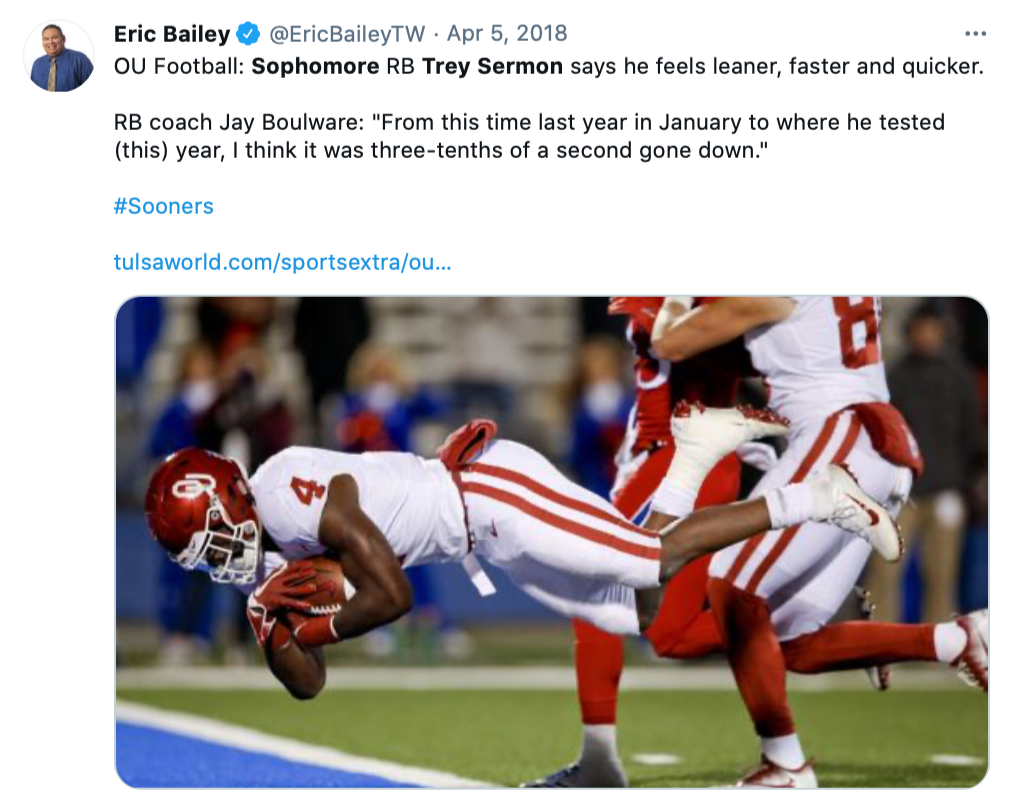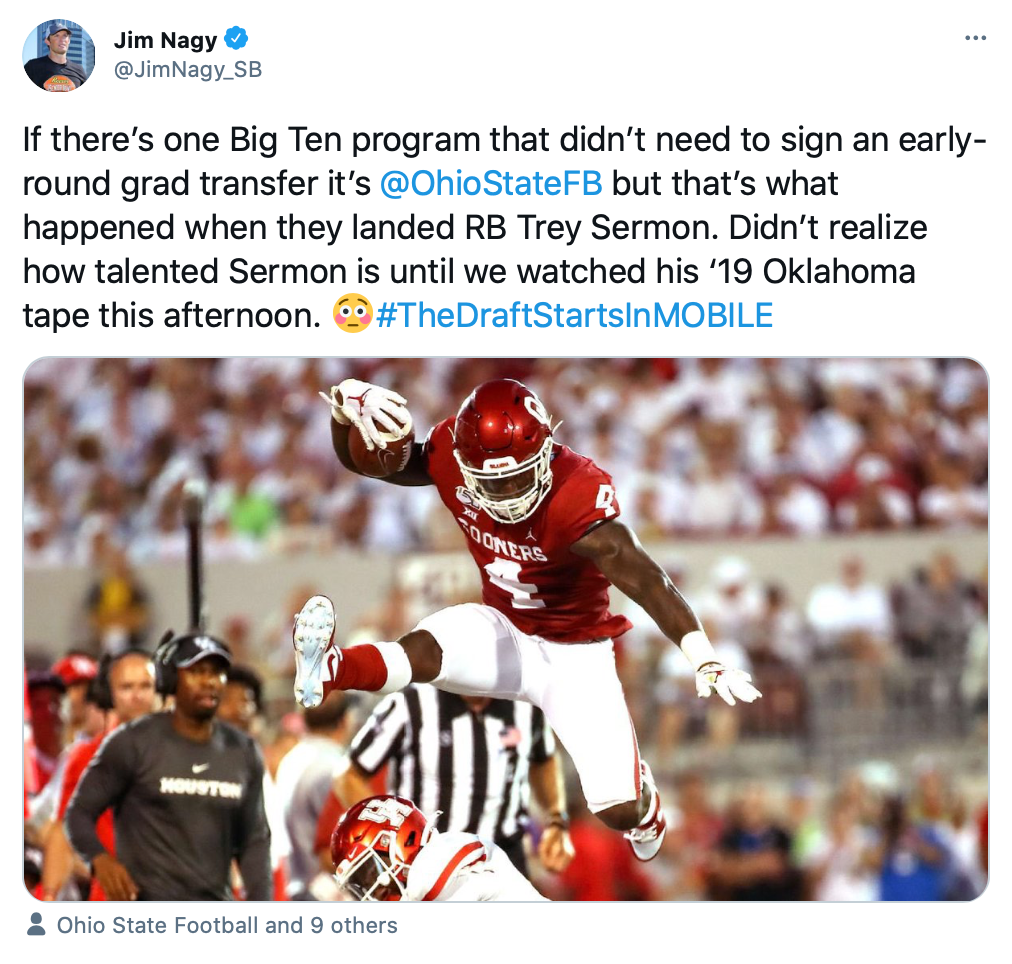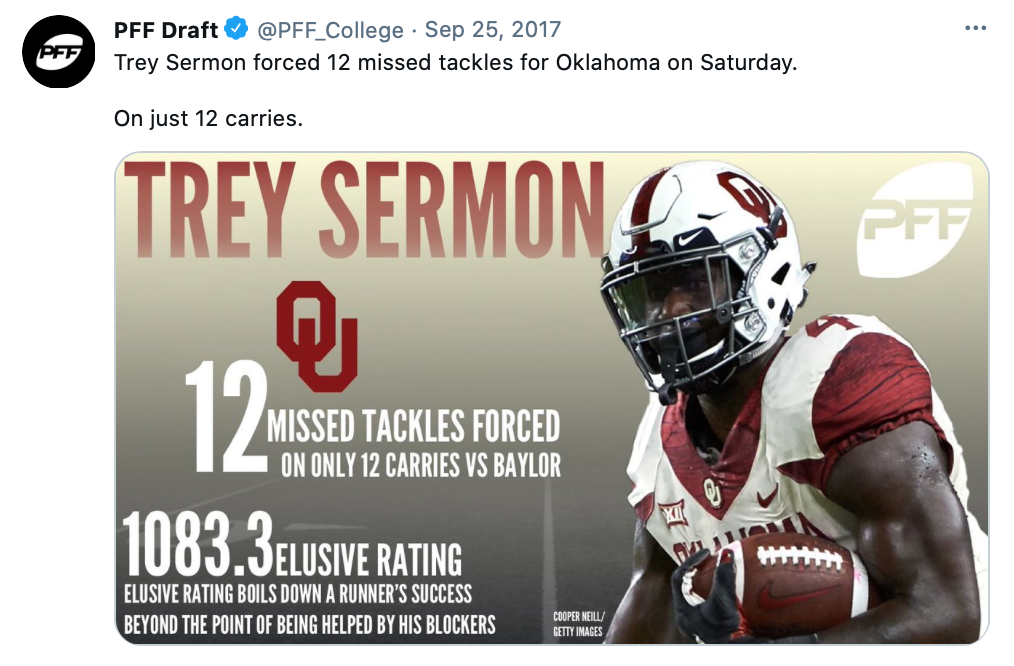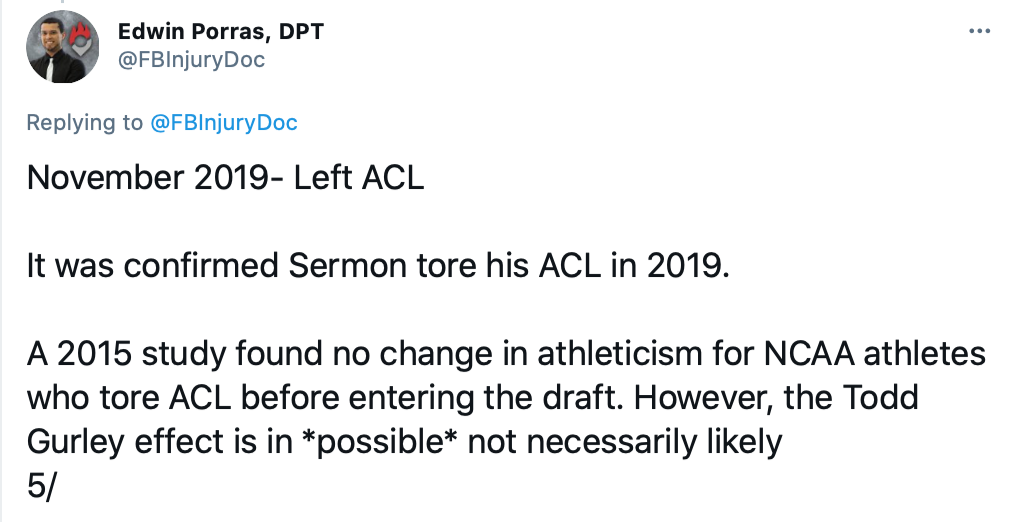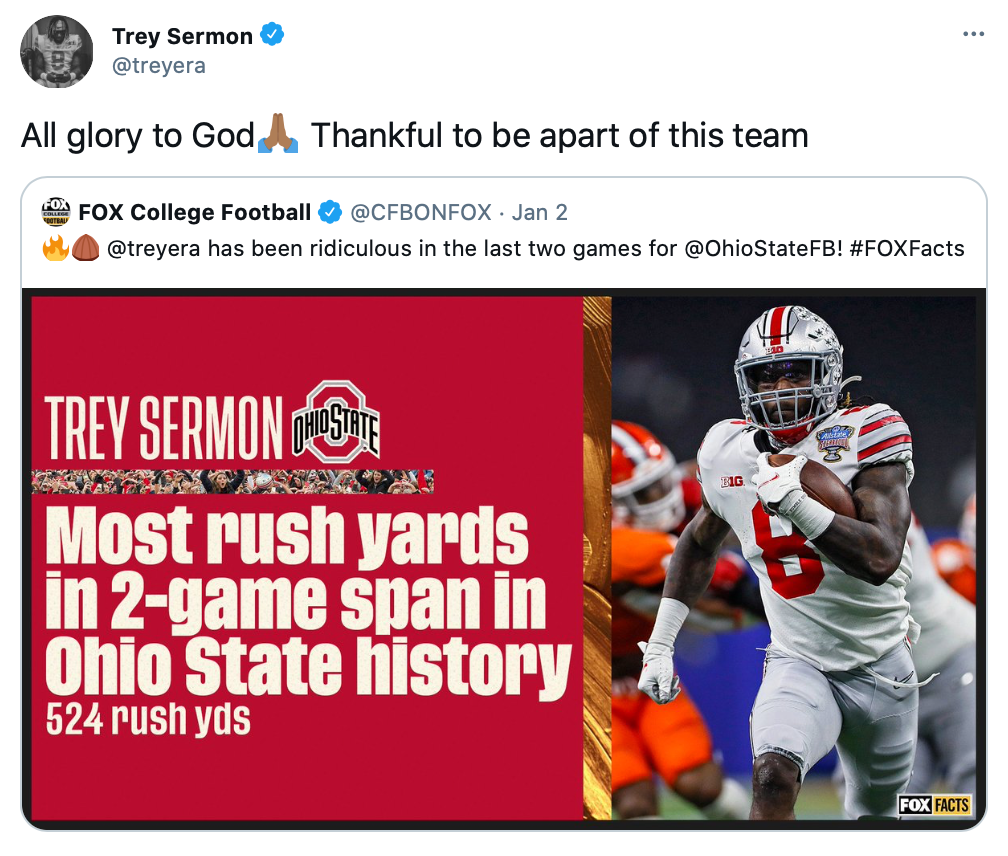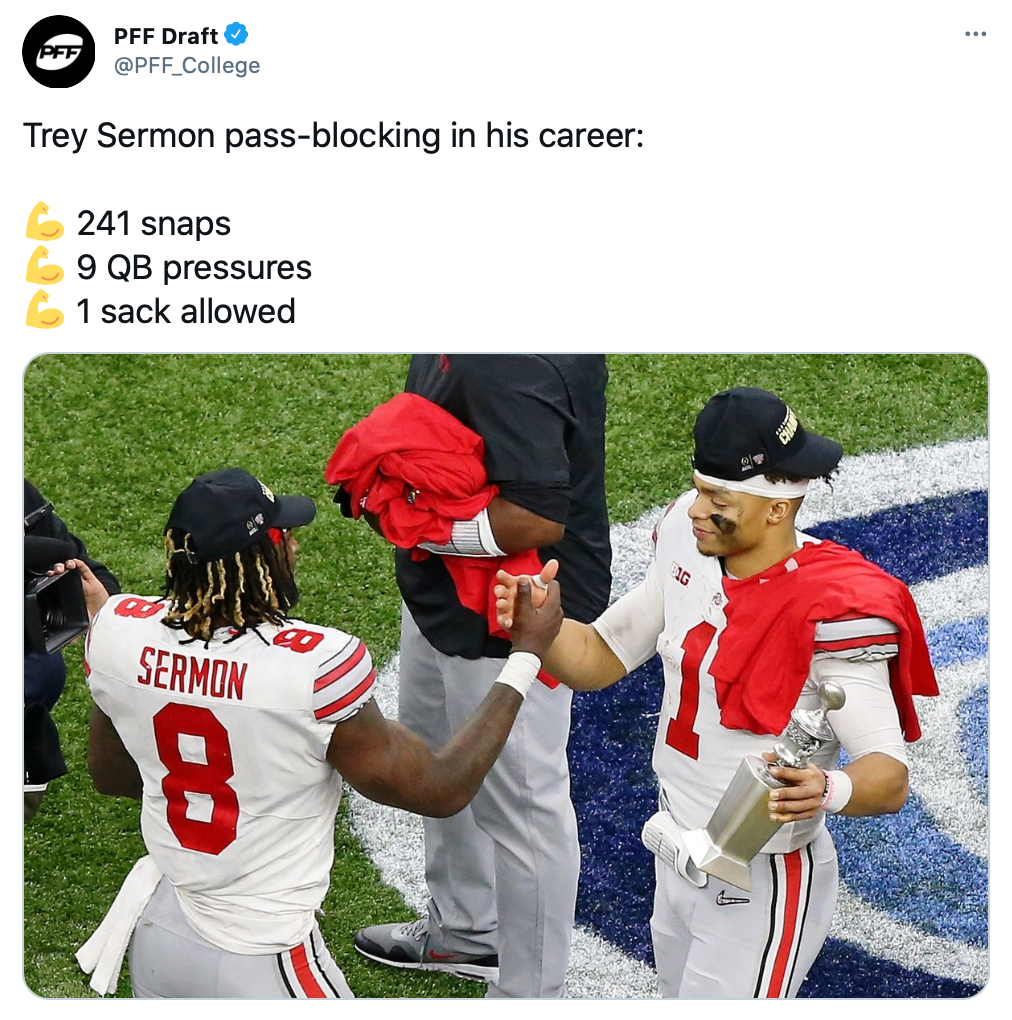Trey Sermon
RB | Ohio State Buckeyes | 6-0 | 213 lbs.
The Story
Trey Sermon has overcome considerable adversity in life, and in his football career. Five years before he was even born, on June 10, 1993, a man murdered his two-year-old brother, Antonio Brazel. Sermon considers details of that time as “horrific tales that he knows only because his mother told him.” Sermon’s Sprayberry High School HC, Billy Shackleford, stated that “he and his mom and that family, they find adverse situations in life and they use it as motivation to move forward.”
Sermon’s football adversity would begin in the first half of the second game of his junior season at Sprayberry High School playing host to Kennesaw Mountain in Marietta, Georgia. A freakish helmet impact to Sermon’s lower back on a TD reception would be the culprit. Sermon immediately knew something was off, heading into the locker room to be checked out after the score. A brief medical check would find nothing, so he would return for the second half to add over 100 rushing yards plus a TD to his stat line. The following game at North Springs, Sermon would rush for over 200 yards with three TDs in the 37-7 victory. But Sermon still felt far less than 100%.
A second opinion on his back discovered a lower lumbar fracture of the L5 vertebrae. The 16-year-old did not take the news in a positive light. Sermon simply did not want to miss even a single game to allow the injury to heal. However, that type of injury “worsens with activity and improves with rest.” The doctors would step in, refusing to clear Sermon to play… obviously a decision with his best interests in mind. After amassing 591 total yards through three games, his junior season would come to a close. Following the required period of rest, Sermon would be fine to return to the field for his senior season.
A series of X-rays several months later would show Sermon had made a full recovery. Considering the young man just rehabilitated from a “broken” back, you could accurately state he did so with a vengeance. In 10 games played, Sermon rushed for 1,227 yards and 16 TDs. Sermon would also attend The Opening Regional in 2016. For whatever reason, he would not participate in the 40-yard dash. But a 4.27 second short shuttle and 34.7-inch vertical jump removed any doubt about his health. He would end up with 33 scholarship offers from schools including Alabama, Ohio State, Auburn, Georgia, Florida, Miami (FL), Michigan, Notre Dame, Oregon, etc. RB coach Jay Boulware would end up helping to seal the deal with Sermon, convincing him to join the Oklahoma Sooners for the 2017 season.
Sermon would make an immediate impact as a true freshman, leading the Big 12 in rushing yards after contact, and ending as a finalist for All-Big 12 Offensive Freshman of the Year. The following season, Sermon became the featured back in earning a 35% carry share. While he would end the season rushing for 947 yards and 13 TDs, the season was filled with — that word again — adversity. Before the official season even started, Sermon injured his right leg in the OU spring game. That said, he would be ready in time for the season opener. Later, in Week 8 at TCU, safety Ridwan Issahaku hit Sermon in that same leg, nearly the exact spot, and he’d need help to reach the sidelines after rushing for 110 yards along with a pair of TDs.
Sermon would fight through the injury without missing a game. Two weeks later, he plastered over 200 rushing yards with three TDs on Texas Tech. In Week 12 against Kansas, he injured an ankle on his very first carry. Once again, Sermon did not want to miss any action to allow the ankle to heal. It was a costly decision that would impact his future with the Sooners. When clearly hobbled the following week at West Virginia, Kennedy Brooks erupted for nearly 200 rushing yards. During their Big 12 Championship victory over Texas and College Football Playoff (CFP) semifinal loss to Alabama, Sermon would actually share the load with Brooks. But his efficiency hit rock bottom.
After the 2019 season, Oklahoma’s RB coach, the same Jay Boulware that made such an impact in bringing him to Norman, would depart for the opportunity to coach at his alma mater, the Texas Longhorns. DeMarco Murray would be hired to fill his shoes. Some rumors have been passed along of a potential rift between Sermon and Boulware. Regardless of the reasoning, a shift in the backfield share would be implemented. However, Sermon splitting carries with Brooks (20% carry share) and emerging star Rhamondre Stevenson (16%) was actually not the most significant reason for a reduced role. The entire backfield would fall in the pecking order behind Jalen Hurts (28%). Sermon still led team RBs with a 22% share until he injured his left knee on his very first carry in Week 11 against Iowa State. His season, and ultimately his Oklahoma career, would come to an abrupt end.
Following the season, Sermon made the decision to enter the transfer portal in search of a featured role. His entry would re-spark a connection with Ohio State RB coach Tony Alford. Sermon eventually made the confident decision to sign on with the Buckeyes after Master Teague III injured his Achilles tendon in early March of 2020. However, the Big Ten season would be delayed due to COVID-19. OSU wouldn’t face off with Nebraska until October 24th. Teague, an athletic specimen, was able to rehabilitate the Achilles injury in time to avoid missing a single snap of live action. After splitting snaps evenly the opening week, Teague took over the lead role during the three subsequent games.
Prior to Week 14 at Michigan State, Sermon’s mentor, Tuna Burhanan, confronted him when he expressed his frustration with falling into the identical situation he faced while at Oklahoma. The conversation put a fire under Sermon. As we’ll see later during the film study, Sermon emerged to face the Spartans as a man unhinged. When Teague was injured in the Big Ten Championship against Northwestern, Sermon erupted for one of the top rushing performances in Ohio State history. He continued that dominating play against Clemson in the CFP.
Sermon essentially took the entire Buckeyes’ offense upon his shoulders, guiding them into the playoffs. And it was a shoulder that would buckle in the National Championship across from Alabama. Tide LBs Christian Harris and Dylan Moses slammed Sermon’s left shoulder into the ground, separating his AC joint — which attaches the collarbone to the shoulder blade, and sending him to the hospital in an ambulance. And it happened on his very first carry of the game.
The Attributes
Maneuvering through the world of high school reporting, film, and statistics can be a complete headache. Team schedules can be out of order, stats fall out of whack when coaches fail to update the data, and very few statements are actually fact-checked for accuracy. Saving you the trouble, I spent more time than I’d prefer to admit tracking down the play in which Sermon injured his back. It’s not surprising at all that Sermon didn’t directly add highlights of the game to his Hudl profile. However, he did add a highlight reel from his junior season that does show the actual play. If you have a weak stomach, don’t be concerned. It’s not a gruesome sight. At 1:22 in the video, Sermon is lined up wide left. After leaping to bring in the Back Shoulder Go for the 26-yard TD, he lands on Jordan Anderson’s helmet. Not the best angle, but that’s all it took.
The very next clip (1:30) is from the second half after being checked out by the team physician. As you can plainly see, the young man shows no signs of injury on the Inside Zone, Read-Option while stiff-arming the LB, and hurdling over the right CB. As the Wildcat QB at 1:53, we see four examples of the cutback ability that he would patent in college. At the 2:03 mark, nobody would imagine Sermon has a “broken” back while breaking four tackles for 40-plus yards into the end zone.
I only show highlights from Sermon’s junior season in high school to bring attention to this kid's toughness. We have more than enough college film to evaluate his future. But far too many label individuals as “injury prone” during evaluations. If you would prefer an actual medical professional to provide an expert opinion on the matter, make sure you read Injury Prone is a Lie, Part I by Dr. Edwin Porras.
Are some players injured more frequently than others? Absolutely. Part of that is a tendency to play with so much effort. Another part is simply terrible luck. For example, the right leg injury suffered during spring ball of Sermon’s sophomore season in Norman was friendly fire from a teammate, tackling him on the side of his knee. It was re-tweaked later that season when TCU’s Ridwan Issahaku hit the same knee in that precise location. In both instances, Sermon fought through the pain without missing a single game. When he was knocked out for the season in Week 11 of ‘19, you can almost guarantee that Sermon fought team doctors to return to the field.
That’s the other characteristic about Sermon I want to spotlight. I love the kid, but it shows his immaturity. Doing everything he can to get back on the field is admirable, but not to the detriment of the team. He hurt his team during the ‘18 season forcing his way back onto the field after suffering what was likely a high-ankle sprain — medical information on college players is kept very close to the vest. The emergence of Kennedy Brooks and, later, Rhamondre Stevenson most likely played a role in his feeling of urgency. Viewing individuals solely from their on-field work will never tell the whole story of a player. Behavioral characteristics play a significant role in their makeup. We expect these kids to immediately behave like adults when they are essentially children. That path takes time.
Fast forward to the ‘21 National Championship, Sermon “didn’t want to come off the field,” and actually returned to the field on the play after his injury. Take a moment to allow that last sentence to settle. No matter what happens during his NFL career, his toughness should never come into question. I’m not a doctor, but I received my degree in biology, and spent a decade in sports medicine. Since we saw for ourselves that Sermon was unable to move his left shoulder, we can reasonably eliminate a Grade I injury. Had Sermon actually collected the targeted throw on the play after his injury, another tackle to the ground could have seriously injured him. Check out these images of what was likely going on with his left shoulder from a Grade II or Grade III injury. Sermon’s shoulder may not have required surgery, but these types of decisions must come to an end when he reaches the NFL.
We don’t have a compiled reel of his true freshman highlights, so let’s begin our study of his college tape with this video of Week 2 at Ohio State. Let’s jump to Sermon’s fourth carry at the 12:45 mark. This is our first example of the Counter concept with the backside tackle and guard pulling out ahead to lead Sermon. RG Quinn Mittermeier is stood up in the backfield by Joey Bosa to stop Sermon after two yards, but it does detail one of his most important run concepts. We see a fine example of Sermon’s elusiveness, cutting ability, and work after/through contact with Inside Zone blocking at 15:08. On average, NFL teams use Inside Zone blocking at a higher rate than any other run concept. At the 28:39 mark, Sermon takes the direct snap on another Counter. Watch as he anticipates his blocking, bursts through the B-gap, shows off his stiff-arm, and always keeps his feet cycling through contact. Many of these are unteachable traits.
At 33:40, we see OU with Inside Zone blocking, the H-back peeling to the backside. We have a proper look at Sermon’s vision in properly diagnosing the left A-gap attack. A very important moment in the game is at 34:34 on 4th-and-3. Trusting in a true freshman RB in that situation facing the Buckeyes speaks volumes. Most backs would’ve been stuffed when Bobby Evans loses leverage on Jerome Baker. But Sermon shifts his attack angle to explode through the C-gap for the conversion.
Now let’s jump back to the 14:18 mark to view his receiving ability. The moment Sermon pulls in this throw, he turns toward the defense to attack with the same arsenal of weapons we see from him on handoffs. That may not seem significant, but the majority of RBs do not display this ability. To become a receiving threat in the NFL, catching the ball is only the first step. The top RBs from this class that offer the same rushing abilities as a receiver are Sermon, Travis Etienne (likely the very best), Najee Harris, Javonte Williams, Michael Carter, and Kenneth Gainwell.
What Sermon does at 28:50 is extraordinary. The playmaking creativity, coordination to convert a designed flare to the flat into a wheel is on another level. Very few NFL LBs would be able to prevent this result. Just ask Jerome Baker.
Let’s shift our focus to Sermon’s 2018 highlight reel. Our first clip is a Counter with Sermon weaving his way through a helpless Florida Atlantic defense. The decision making, vision, cutbacks, and explosiveness are on full display. Skipping to 0:24, we see the variant of Counter with a fullback in place of the backside tackle. Watch how Sermon hesitates in order to allow his blocking to develop. In order to properly attack with Counter blocking, you need a RB with the patience of a saint. Since Sermon understands that, he knows he’ll only need to get past the safety, Braxton Lewis, for a big run.
At the 0:33 mark, the Inside Zone blocking is actually designed for Kyler Murray. ISU CB Brian Peavy falls directly into Sermon’s trap, committing the inexcusable mistake of losing primary contain chasing the RBs hips to the inside of the flat block. As if that weren’t enough, Sermon then slices through three tackle attempts on his way to paydirt. Did I mention Sermon has a pretty good cutback? How about the continual footwork to shed tackles? The run at 0:45 highlights a money trait from Sermon. Notice how he never shows extended bursts in a single direction. His bursts are tactical. He’s not just setting up a single defender, he’s manipulating multiple. And the way he powers through the pile at the end of the play showcases how well he focuses his momentum — always forward. True shades of Ezekiel Elliott.
Over one-third of all of Sermon’s carries with the Sooners would be with Counter blocking in front of him. In all three seasons, he would average at least seven yards on every one of those attempts. At the 1:06 mark, we see Sermon doing something that became one of his trademarks… bouncing his run — intended here to be inside of H-back Grant Calcaterra’s block — to the outside of right end. Focus on his work after contact. I would only place Etienne and Javonte Williams ahead of Sermon as the top RBs in the class working after first contact.
We have a prime example of Sermon as a receiving threat at 1:25 in the video. Sermon is constantly changing direction, cutting away from the defensive leverage. It’s the exact same mindset he utilizes after a handoff. Sermon is the epitome of a back who gets better with every touch. The more opportunities, the better the chance that he’ll explode for field-flipping yardage. More of the same is shown in the next clip (3:43). As you watch the rest of the highlights, notice how every detail I’ve circled is continually shown play-after-play. These aren’t simply big plays for Sermon, the technique is ingrained into Sermon’s DNA. These are visions of Sermon, not of simple football moves. His work is seamless, maniacal.
For the 2019 season, we’ll use this video. After a breakout true sophomore season, Sermon’s opening performance facing Houston gave every indication for an upcoming monster year. The opening clip shows Sermon blazing a trail through the Cougars behind Inside Zone blocking. We see all of the same burst, vision, decisiveness, and maneuverability. If it’s not already clear by this point, use 1:33 as the reason for hoping Sermon lands within a rushing system able to pull off Counter blocking. It’s by forcing defenses to stop Counter attacks that set up what we see at 2:23 in the video. On a true Counter, Sermon would step right here, and turn to run left — hence the “Counter” steps. On this play, Sermon never steps back left toward his blocking, rather bolting away from his O-line leverage with Calcaterra setting the edge in the flat. Even at his size, Sermon in space is a dangerous prospect.
During the entirety of his college career, nearly a third of all of Sermon’s TDs would be scored off right end. That’s a tendency he shares with Christian McCaffrey and, once again, Zeke Elliott. Using his vision, patience, and bruising style, we see why at 0:53. Another example of Sermon fabricating receiving offense on a flare-to-wheel conversion is shown at 0:35. To top it off, we get him hurdling over a defender late in the play. This kid is simply oozing athleticism.
If you’re squeamish, skip to the next video. We actually have the play Sermon was injured against Iowa State at 3:22. We see all of his classic moves culminate with Cyclones’ LB Marcel Spears Jr. and safety Braxton Lewis going high-low to bring him down at the expense of his right knee. Nothing about the result involves being “injury prone.” This precise sequence of events would spell doom for any player.
Let’s skydive into the ‘20 footage of Sermon, now wearing Scarlet-and-Gray, with this video. The Nebraska game stood as an opportunity to separate himself from Master Teague III. That’s much easier said than done. Sermon definitely didn’t nosedive, but the Buckeyes’ offense is quite different from Oklahoma’s. In his eight games played for OSU, Sermon would be served Counter blocking on all of two attempts. In Columbus, it’s all about Inside, Outside Zone, and Man blocking.
The Man blocking stands as the biggest obstacle to his style. The design involves attacking with the O-line stepping away from the handoff direction. Over his first four games with the team when Teague ran the show, Sermon would have his O-line Man blocking at twice the rate that he would see during his historic stretch. Our first Man blocking example is shown at 0:42. You can see the considerable difference in available attack lanes. Many times, the concept will only clearly offer a single optimal gap of attack. Sermon finds it, doing what he can in the secondary role behind Teague.
On the second play in the video (0:25), the O-line is Outside Zone blocking for Sermon. We see all of the Sermon classic characteristics slicing through the Cornhuskers’ defense. The same is true at 0:33, this time facing one of the most talented run defenses in the nation, Penn State. One of the more entertaining games of the season was Week 9 vs. Indiana. Teague and Sermon combined for 163 yards against that extremely talented D-line. At 0:48, Sermon shows off his straight-line speed.
Whereas Sermon played well over his first four games, we see him reach another level of himself starting at 1:05 in the video. The first play is actually Man blocking. Same collection of moves from Sermon, but the determination has changed. Instead of waiting for his coaches to notice his ability, he forces the action. The result is impressive. You can see the explosion of emotion at the end of the run. You then see him outrun Tre Person, almost 50 pounds lighter at 5-foot-11, 170 pounds, to the end zone at 1:14.
Onto what is one of the most impressive rushing performances in the history of college football. Northwestern came into the contest ranked as one of the top-20 rushing defenses in the country. When the game would come to an end, they would leave ranked outside the top-70. Sans Najee Harris, no other back offers a better functional jumping ability than that of Sermon (1:26). When the passing offense stalled without Chris Olave — COVID contract tracing — Sermon took over. His combination of jump-cuts and acceleration (1:32) obliterated a talented collection of defensive playmakers. Sermon is able to generate bone-crunching pop when given a chance to collect his momentum (1:42).
One of the most memorable carries from the ‘20 season is shown at 1:48. Words would dishonor the viewing impact. Remarkable. It’s off to the races on nearly every handoff, with Sermon chaining together moves. His decision making is so flawless that the entire Wildcats’ offense seems to disappear until Sermon has already reached the open field. The remaining handoffs against Northwestern are simply eye candy for the soul.
We have Sermon against Clemson beginning at 3:00. On the play, Sermon is back to his old tricks, turning this flare to the right flat vertical in order to build up his momentum. I still think the Buckeyes lose the National Championship with a healthy Sermon, but the receiving work we see here would have been devastating to the overly aggressive Alabama front-seven. You hear the “shot out of a cannon” idiom tossed around too lightly. If you want a true example, look at 3:09 in the video. Seemingly from the very first step, Sermon reaches top speed. He carries that exact velocity all of the way to the end zone. The work after contact at the conclusion of the 3:17 play looks so much like Elliott. We get two views of his 31-yard run starting at 3:30. At this point, what Sermon does cannot be described any differently. It’s at the highest level in the game.
Fantasy Fit
Sermon didn’t put together the most impressive college career (Travis Etienne) or culminate with the finest season from ‘20 (Najee Harris). But that three game stretch against Michigan State, Northwestern, and Clemson did more for his NFL future than any other RB did in six games this past season. Some will question Sermon’s injuries. I feel the video definitively proves these injuries were freak occurrences.
Some will ask why he wasn’t able to seize the lion's share of carries from Kennedy Brooks in 2019 — Sermon did actually lead in carry shares prior to his injury. Not to mention that it was Hurts who headlined that rushing attack. In addition, Brooks is easily a top-10 Devy RB. If you’re asking that question, take some time to watch some footage of Mr. Brooks. The guy is going to ball out in the NFL one day. As for the same question about the situation with Master Teague III, you have the same exact answer. Teague is truly an athletic specimen whom will be highly regarded by NFL teams.
Nobody should need to convince you of anything on Sermon. He has as much NFL-level talent as any RB in this class. Some of the top in the class possess traits slightly better, in other areas, Sermon stands above the rest. The biggest omission from this film breakdown was of Sermon’s pass protection. During his four seasons protecting Baker Mayfield, Kyler Murray, Jalen Hurts, and Justin Fields on nearly 250 snaps in pass pro, he allowed a defender to make contact with his QB on two occasions. Sermon is the unquestioned top blocking RB in the entire class. He is also the most accomplished back in front of Counter blocking — Javonte Williams is actually a very close second.
Looking at the Counter-heavy, RB needy NFL teams… Miami, Pittsburgh, and, maybe, Arizona stand out. Despite possessing first-round traits, Sermon is unlikely to cost first- or early second-round draft capital. It’s been reported that the Dolphins are in the market for an RB1. The Steelers are likely to let James Conner walk, and also have a history of using their early picks to bolster their defense. Both teams would be dynamite landing spots for Sermon’s abilities.
The Bottom Line
As for a player comparison, the clear one-to-one is Ezekiel Elliott. But I would rather comp Sermon from the neck up to Le’Veon Bell, and the rest of him to Zeke’s characteristics. The biggest obstacle for Sermon is himself. He must take care of himself. He must trust in his doctors. An NFL career can be a fleeting experience. He must also keep things simple. Worrying about his role, the role of others is a slight concern. As long as Sermon focuses on the things he can control, he will provide us with a solid 10 years of production. I’d extend that estimation even further if I knew he would follow health protocols.
When we draft our Dyno backs, we want all of the important trait boxes checked. You get that, at the very least, with Sermon. He is a bigger back with plenty of room to pack on additional muscle. Now that is scary. His combination of size, strength, and speed is only bested by Najee. His work after first contact is phenomenal. Over his career, nearly 60 percent of his yardage was gained after contact. Just like Harris, Sermon is one of the few RBs in this class with three-down potential. Three-down potential = fantasy dynamite. The questions I’ve detailed do drop Sermon down a tier for me below Najee and Etienne. We need to decide between Sermon and Javonte — another RB I feel possesses three-down potential — as our RB3. For me, it’s Sermon by the slimmest of margins.


